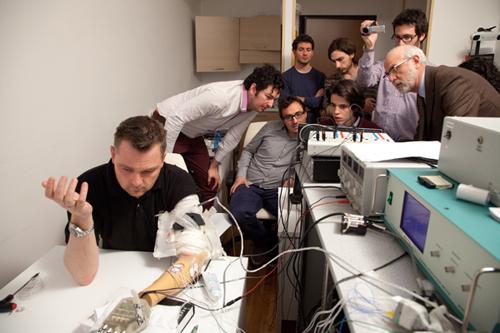 Nine years after an accident caused the loss of his left hand, Dennis Aabo Sørensen from Denmark became the first amputee in the world to feel – in real-time – with a sensory-enhanced prosthetic hand that was surgically wired to nerves in his upper arm.
Nine years after an accident caused the loss of his left hand, Dennis Aabo Sørensen from Denmark became the first amputee in the world to feel – in real-time – with a sensory-enhanced prosthetic hand that was surgically wired to nerves in his upper arm.
The team at EPFL Center for Neuroprosthetics in Italy developed the revolutionary sensory feedback that allowed Sørensen to feel the difference between an orange and a baseball when handling the objects.
“The sensory feedback was incredible,” reports the 36 year-old amputee from Denmark. “I could feel things that I hadn’t been able to feel in over nine years.”
In a laboratory setting wearing a blindfold and earplugs, Sørensen was able to detect how strongly he was grasping, as well as the shape and consistency of different objects he picked up with his prosthetic. “When I held an object, I could feel if it was soft or hard, round or square.”
From Electrical Signal to Nerve Impulse
Micera and his team enhanced the artificial hand with sensors that detect information about touch. This was done by measuring the tension in artificial tendons that control finger movement and turning this measurement into an electrical current. But this electrical signal is too coarse to be understood by the nervous system. Using computer algorithms, the scientists transformed the electrical signal into an impulse that sensory nerves can interpret. The sense of touch was achieved by sending the digitally refined signal through wires into four electrodes that were surgically implanted into what remains of Sørensen’s upper arm nerves.
“This is the first time in neuroprosthetics that sensory feedback has been restored and used by an amputee in real-time to control an artificial limb,” says Micera.
“We were worried about reduced sensitivity in Dennis’ nerves since they hadn’t been used in over nine years,” says Stanisa Raspopovic, first author and scientist at EPFL and SSSA. These concerns faded away as the scientists successfully reactivated Sørensen’s sense of touch.
(WATCH the video below or READ the story from EPFL)



















